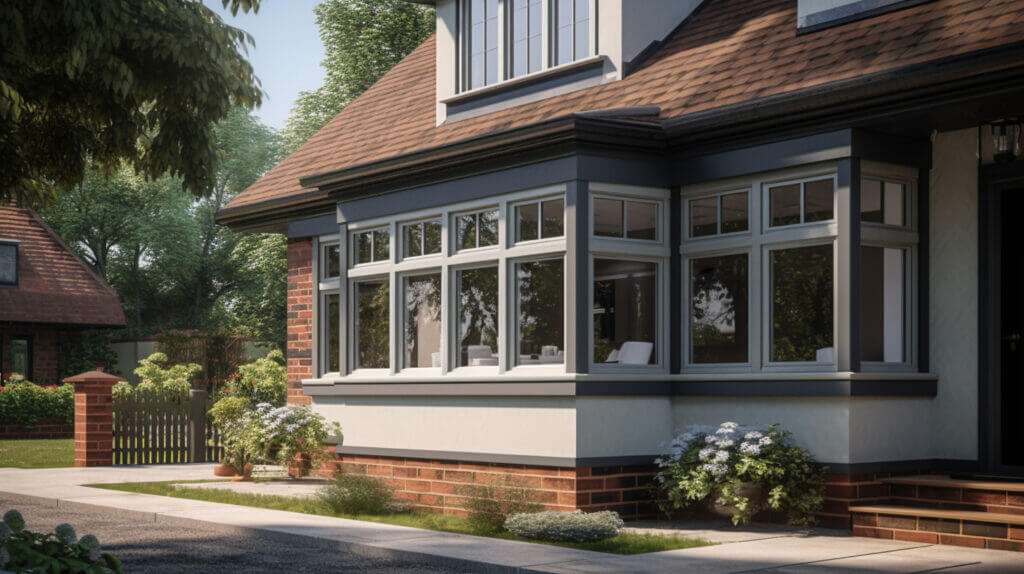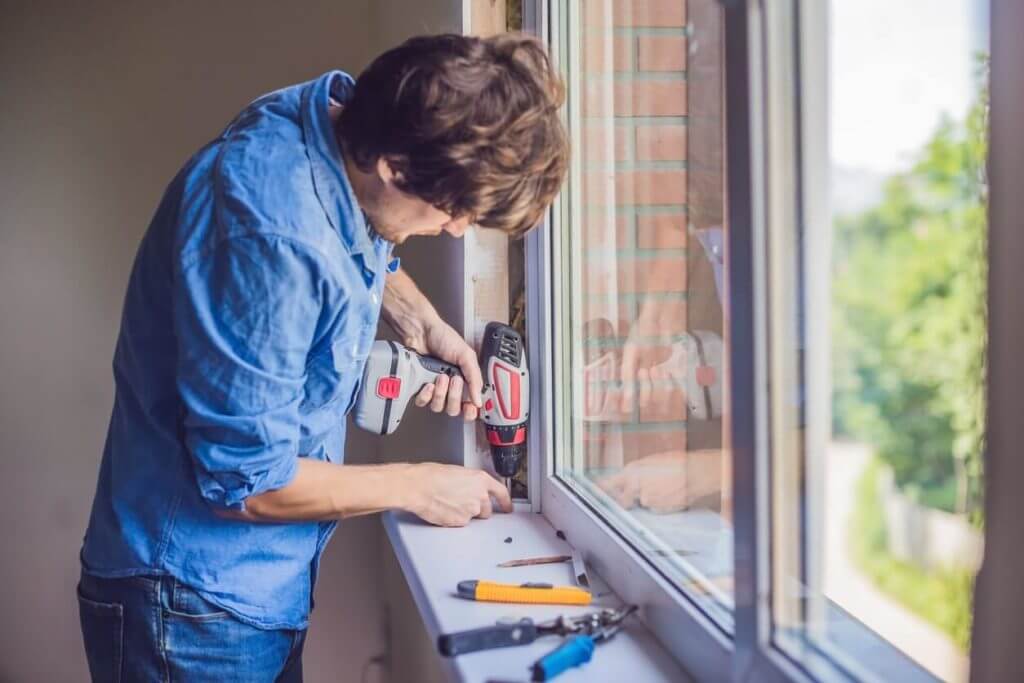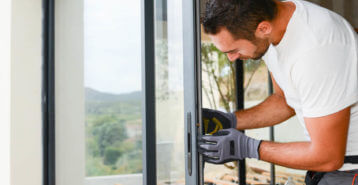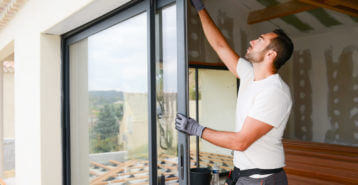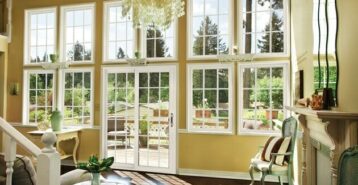- How Much Does a Window Replacement Cost?
- Average Cost of a Window Replacement
- Costs by Window Type
- Window Replacement Cost by Frame Material
- Window Replacement Cost by Glass Type
- Costs by Window Type
- Costs by Window Brand
- Energy Efficient Cost
- Whole House Window Replacement Cost
- Labor Costs for New Windows
- Window Replacement Cost Factors
- Additional Costs and Considerations
- Should I Replace My Windows?
- How to Save Money on Replacement Windows
- Final Thoughts on Replacement Window Costs
- Frequently Asked Questions
How Much Does a Window Replacement Cost?
The average cost to replace windows in your home is $614 to $1,309 per window as of 2024. This cost is per window, and it includes:
- The price of each window, which will vary by window type, frame type, and glass type, all of which are detailed below. Overall, you can expect to pay somewhere between $383 to $815 per window for the window itself. This is the “materials cost.”
- The cost of professional installation and labor. On average, you can expect to pay between $70 and $150 per window in installation costs depending on how simple or complex your window replacement is.
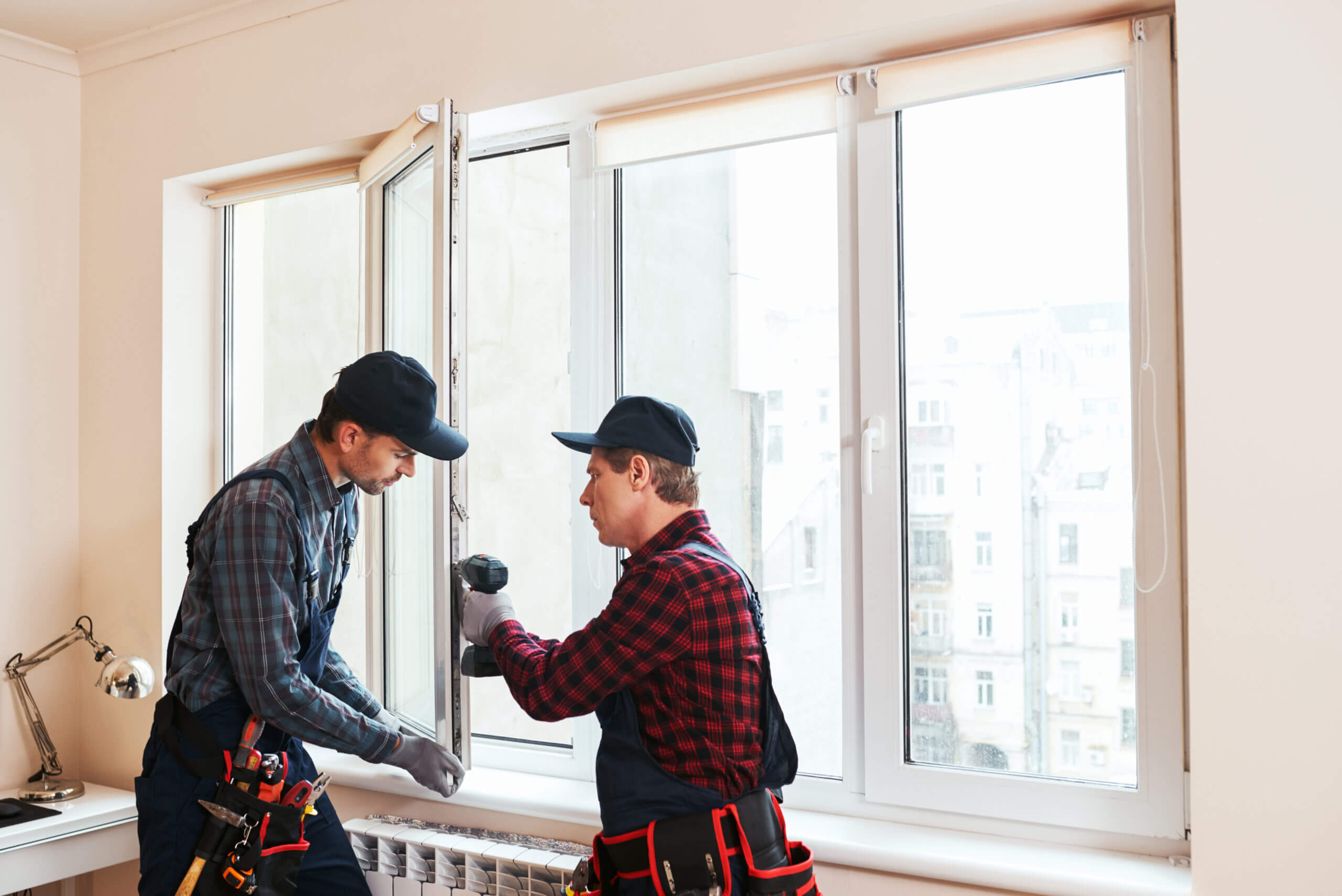
Home Window Replacement
Average Installation Cost $614 - $1,309
Cost Breakdown
- Materials 85.7%
- Labor 14.3%
Of course, no window replacement is exactly the same, and costs can vary from project to project. Let’s take a closer look at what impacts these costs so you can better estimate where you will fall in the above price range.
Average Cost of a Window Replacement
The following factors and choices can impact the estimated cost of your window replacement:
- Window style: This is also commonly referred to as “window type.” In short, a single-hung window costs more than a double-hung window, but a bay window costs more than both. The type or style of window you choose will be a major factor in your materials cost. Not sure what kind of window you want? We’ll cover popular styles and their average costs below.
- Window frame material: Is it a vinyl, wood, aluminum, or fiberglass window? We will break down what each frame type is best for and their average costs below.
- Window size: How big of a window do you need to have installed? A small window in your bathroom will cost less than a large living room window.
- Window glass: Glass is an expensive component of your materials cost. You can choose from insulated, tempered, privacy, or a combination of these.
- Energy efficiency: Do you want energy efficient windows, such as double pane, triple pane, thermal, or ENERGY STAR rated? They cost more up front but can save you money on your utility bills once they’re installed, so they will save you money in the long run.
Let’s take a look at three different cost examples so you can get a better sense of what you can expect in a lower cost, medium cost, and high cost window replacement. First, take a look at the table below to see average cost ranges, and then read more about what each of those cost ranges include.
| Project Budget Range | Average Prices |
|---|---|
| Low | $150 - $400 |
| Medium | $400 - $700 |
| High | $700 - $1,200+ |
Low-Cost Window Replacement
- Price range: Typically, low-cost window replacement projects range from $150 to $400 per window.
- Window type: Basic single or double-hung windows are common in this range.
- Frame material: Vinyl is the most cost-effective material. It’s durable, requires little maintenance, and provides decent insulation.
- Glass type: Standard single-pane glass is common in this price range. However, some may offer double-pane glass without additional features like argon gas filling or low-E coating.
- Installation complexity: Simple replacements in standard sizes and with minimal structural modifications. The cost can stay low if the existing window frames are in good condition and can be used for the new installation.
Medium-Cost Window Replacement
- Price range: Medium-cost projects usually fall between $400 to $700 per window.
- Window type: More variety in styles, including casement, sliding, and possibly some custom sizes.
- Frame material: Higher-quality vinyl or basic wood frames. Fiberglass frames might also be an option in this price range.
- Glass type: Double-pane glass with energy-efficient features such as low-E coatings or argon gas fill is standard. These features improve insulation and energy efficiency.
- Installation complexity: May include some customization to fit the window openings or minor modifications to the home’s structure. The installation process might be more involved compared to low-cost options.
High-Cost Window Replacement
- Price range: High-cost window replacements can range from $700 to $1,200 or more per window.
- Window type: Includes specialized designs like bay or bow. Custom sizes and shapes are also typical in this range.
- Frame material: High-quality wood, fiberglass, or composite materials can be chosen in this price range. These materials offer the best in aesthetics, durability, and insulation.
- Glass type: Triple-pane glass with advanced energy-efficient features such as UV coatings, inert gas fills, and thermal spacers. These provide excellent insulation and noise reduction.
- Installation complexity: Often involves significant customization and potential structural changes to the home. Installation might require more skilled labor and take longer, which contributes to the higher cost.
Window Replacement Cost Calculator
To get a more specific estimate of what your project will cost, you can use our window replacement cost calculator at the top of this page. You’ll start by selecting the type of window you want, followed by your ideal frame type. Then, choose what kind of glass you believe you need. Finally, choose how many windows you want to replace total, and then enter your zip code so we can estimate labor costs in your area.
Modernize does not ever ask for your email or phone number in order to get your estimate.
Window Replacement Cost by Frame Material
When replacing home windows, you will have the option to choose between different window frames like vinyl, wood, fiberglass and aluminum. Each material comes with a different price tag, durability level, and quality level.
For example, vinyl windows are known for being as affordable as $400 per window, whereas clad wood composite windows are highly durable and come with a higher price tag, up to $1,800 per window.
Below you can explore the average costs and benefits for each window frame material. Note that these window replacement costs are based off of a standard sized double-hung window, which is the most common window type across homes in the United States. Costs will go up for higher-end window styles.
| Window Frame Type | Average Cost Per Window |
|---|---|
| Vinyl Windows | $391 to $834 |
| Aluminum Windows | $397 to $846 |
| Fiberglass Windows | $320 to $683 |
| Wood Windows | $875 to $1,865 |
| Composite Windows | $950 to $1,800 |
You can read more about each of these options by reading our guide to types of window frames. Here are the basics you need to know:
- Aluminum. This may be the best option for you if you want something that is very low-maintenance and lasts a long time. However, it is not always very energy-efficient. Check out our guide to aluminum window frames for more information.
- Composite. Made from a combo of wood and either aluminum or vinyl, these are one of the most expensive options due to their excellent longevity, durability, and energy-efficiency. Our guide to composite window frames can tell you more.
- Vinyl. These are the most popular option due to their fairly good energy-efficiency and low price point, but are not suitable for all climates. Read more about vinyl window frames in our guide to see if they’re right for you.
- Fiberglass. This frame costs more than vinyl, but it also more durable, lasts longer, and is more energy-efficient. See if fiberglass window frames could be a good fit for your home by reading our guide.
- Wood. These are expensive and require quite a bit of maintenance, but they are also beautiful and durable. You can read more about them in our guide to wood window frames.
Window Replacement Cost by Glass Type
The type of window glass you choose can help make your home more energy efficient and reduce your utility bills. Energy efficient glasses reduce the transfer of heat through the window, thereby reducing the amount of energy you need to keep your home warm in winter season and cool in the summer. Apart from energy savings, window glasses can also help with noise reduction, impact resistance and privacy.
The cost of replacing window glasses can range from $280 to $325. Below you can explore the average cost to replace each type of window glass as of 2024.
| Type of window glass | Average cost to replace |
|---|---|
| Single pane glass | $100 to $400 |
| Double pane glass | $613 to $1,307 |
| Triple pane glass | $400 to $700 |
| Low E glass | $350 to $850 |
| Gas-filled glass | $375 to $1,000 |
| Laminated glass | $275 to $600 |
| Tempered glass | $175 to $600 |
| Frosted glass | $300 to $700 |
Window Replacement Costs by Window Type
If you are deciding which new home window types you want to install, it is helpful to look at the different costs of each window style beforehand. For example, a standard size double hung window is one of the most affordable types of windows, costing an average of $608 per window to install. On the other hand, a large picture window costs an average of $889 or more per window to install.
Window types that require a higher skill level to install can also require more labor time, which will cause the window installation cost to rise. See the different costs of window styles below in our price chart:
| Window Type | Average Cost Per Window |
|---|---|
| Single Hung Windows | $397 to $847 |
| Double Hung Windows | $429 to $915 |
| Arched Windows | $345 to $950 |
| Awning Windows | $477 to $1,107 |
| Bay Windows | $1,732 to $3,690 |
| Bow Windows | $1,810 to $3,859 |
| Casement Windows | $597 to $1,273 |
| Circle Windows | $450 to $1,200 |
| Egress Windows | $160 to $750 |
| Garden Windows | $1,350 to $1,800 |
| Glass Block Windows | $450 to $1,100 |
| Hopper Windows | $170 to $645 |
| Jalousie Windows | $175 to $375 |
| Picture Windows | $609 to $1,298 |
| Skylight Windows | $900 to $2,500 |
| Sliding Windows | $775 to $1,652 |
| Sliding Glass Door Windows | $1,070 to $2,690 |
| Storm Windows | $172 to $320 |
| Transom Windows | $334 to $711 |
| Average Labor Costs | $70 to $150 per window |
Our extensive guide to types of windows covers all you need to know, but let’s take a look at the most popular window types you will likely be perusing:
- Single-hung. This window has one moveable shaft and opens vertically. It is a good option for lower budgets, first floors of homes, and areas that need egress.
- Double-hung. The most popular window in the U.S., it opens vertically via two moveable sashes — one at the bottom and one at the top. This makes it ideal for airflow in areas like kitchens as well as for higher floors of your home where heat rises.
- Picture. An affordable window type that allows for unparalleled views due to its one unbroken piece of glass. However, it achieves those views by not having any moving parts, so be aware this window does not open.
- Casement. Another window type that allows for a more unbroken view than other window styles, casement windows are growing in popularity. They open by pushing out instead of sliding up.
- Sliding. If you have an especially long or narrow wall space, a sliding window will fit there well while still allowing for excellent airflow. It slides open horizontally instead of vertically.
- Bay. This pricey window type protrudes from the exterior of the home, which creates additional space inside the home, too. It is created via three or more windows put together, of which at least one is usually operable.
- Awning. Similar to a casement window, an awning window opens outwards instead of sliding. However, instead of pushing open from the side, it pushes open from the bottom, creating an awning when fully opened.
Keep in mind that the majority of homeowners need to replace or install several windows at a time, sometimes as many as 20 to 30 windows during a single project. The best way to determine how many windows you need to install or replace is to set up an appointment with a qualified local window contractor, who can visit your home and make recommendations.
Window Replacement Cost by Brand
When you are looking at prices per replacement window, you can expect to pay more for high quality window brands such as Simonton, Milgard, Marvin, or Pella windows.
To give you an idea of how much to expect to pay for each window brand, we took a standard size vinyl double hung window from each of the brands to create the price chart below for comparison. Each window brand offers different price tiers for upgraded features, better frame types, longer warranties, etc. Note that special discounts for certain window brands might be available through working with contractors in your area.
| Window Brands | Price Per Window | Cost to Install |
|---|---|---|
| Pella Double Hung Windows | $185 | $295 |
| Andersen Double Hung Window | $235 | $381 |
| Harvey Double Hung Window | $275 | $368 |
| Certainteed Double Hung Windows | $285 | $392 |
| Milgard Double Hung Windows | $287 | $425 |
| Marvin Double Hung Windows | $300 | $415 |
| Atrium Double Hung Window | $312 | $415 |
| Simonton Double Hung Windows | $375 | $495 |
When deciding which top window brand is best for your window replacement project, you can start off by asking the following questions:
- What is your budget for installing new windows?
- What window features, like frame material, sizes, and energy efficiency, are provided by each brand?
- What is the warranty and customer service like?
The only way to get an accurate price for a certain window brand is to get in touch with a reliable contractor in your area, as window brand prices change by location, installer, and possible tax credits, rebates, or special offers exclusive to your area. Reach out to our reliable contractors today to get a price quote.
Energy Efficient Cost
There are quite a few energy efficient features for new home windows, including double paned or triple paned glass, high energy star ratings, argon gas fills, low-e coatings, sound proofing, and much more. The upfront cost for energy efficient windows is typically higher than standard windows, at about $500-$3,100 per window. However, these custom options will help build your windows’ energy efficiency rating and save you money on future utility bills – as much as $465 per year.
Keep in mind that as you add on energy efficient features, the total window replacement cost can go up – but the long-term savings are often worth the upfront cost. Our guide to all the different window ratings that are available and what they mean can help you figure out which efficiency upgrades you should be looking for.
Whole House Window Replacement Cost
Many homeowners opt to replace all their home windows at once. There are a few reasons for this:
- Many window replacement companies offer discounts and savings when replacing several windows at the same time.
- Most homes have all windows installed at the same time – when the home was built. Window frame lifespans average 20 to 50 years, so if your windows were installed during your home’s construction 20+ years ago, it may be time to replace all the windows during the window replacement project.
- Replacing all your windows at once ensures continuity of window style. In other words, you don’t have to worry that your manufacturer of choice is going to discontinue the window color, type, etc. you chose.
Below, we’ve created a table showing the average number of windows organized by a home’s square footage, along with a price range for a low, medium, and high cost project.
| Square Footage | Average Number of Windows | Project Cost Ranges |
|---|---|---|
| Under 1,000 | 8 to 10 | Low: $750 - $4,000 Medium: $3,200 - $7,000 High: $5,600 - $12,000 |
| 1,000 - 2,000 | 10 to 15 | Low: $1,500 - $6,000 Medium: $4,000 - $10,500 High: $7,000 - $18,000 |
| 2,000 - 3,000 | 15 to 25 | Low: $2,250 - $10,000 Medium: $6,000 - $17,500 High: $10,500 - $30,000 |
| 3,000+ | 25 to 40 | Low: $3,750 - $16,000 Medium: $10,000 - $28,000 High: $17,500 - $48,000 |
For a more specific estimate, we recommend you do the following:
- Count your windows. Go through every room of your home, including bathrooms, your laundry room, and your basement.
- Note how many are big, medium, and small. As you count, keep track of how many are an average size vs how many are smaller and larger than average. Our guide to window sizes can help you determine what an average size is.
- Will they all be the same type? Chances are they won’t be. As you go through your home, note how many of your windows open and close (windows that are operable) and how many don’t (windows that are inoperable).
- Do all your windows need the same kind of glass? For example, you may choose to have low-e glass in windows that see a lot of afternoon sun in the winter but not have low-e glass in every window.
Then, you can either use our cost calculator above or manually figure out what an average cost may be for each set of windows.
It is important to create a budget for the cost of your entire project before getting started. The best way to do this is to set up an appointment with a local contractor to get an estimate based on your home and needs.
One final note on replacing all your house windows at once: sometimes, window replacement costs can be negotiated with bigger projects or discounted with specials being run in your area by window installers.
Labor Costs for New Windows
On average, you can expect labor and installation costs to be an average of $70 to $150 per window for most standard sized window types. However, window replacement labor costs can vary by your home’s location, which type of window you are installing, and how long the project takes. Most window contractors replace windows at an hourly rate.
If your window installation requires creating a new opening in your home, then the time it takes to complete the project can expand, which means labor costs may increase as well. It may also require more skilled workers familiar with installing larger or more complicated window types (garden windows, bow and bay windows, or large arched windows), thus raising total installation and labor costs.
Disposal of job related debris and clean up of the site is often added to the labor costs separately by contractors. It will be added to the number of hours for the job, but may require additional transportation cost if the disposal items are not easy to move.
In general, you can expect to pay more for labor in areas with high demand and high costs of living. For example, the cost for a replacement window in Austin, TX may be more expensive in terms of labor compared to a small city in Texas with plenty of local hometown window installers who offer affordable rates.
Window Replacement Cost Factors
In addition to the type of window you choose, the frame material, and the glass type, some elements of a window replacement project bring costs you should be aware of. These include:
- Home size. While a larger home will of course have more windows than a smaller one, your home’s size impacts your project in other ways, too. Bedrooms will need windows that meet egress requirements, which means cheaper options like picture windows aren’t available to you.
- Window location. Are you replacing ground floor windows or higher level windows? Windows in a one-story home will be much easier (and thus cheaper) to replace than windows on the third floor of a townhome. Ask your contractor if any exterior work needs to be done to get your windows installed or if the windows can be installed from inside.
- Permits. Many states now require a permit to be pulled before replacing your windows, and the costs of those permits can vary. Check our our guide to window permits to learn more.
- Retrofit vs full frame replacement. You may be able to keep or repair your existing window frame if it’s in good shape and not terribly old, which can save you a lot of money. Check out our guide to window glass replacement cost for an estimate.
Additional Costs and Considerations
Here are a few other things that you may need for your windows that you should factor into your budget:
- Weatherproofing. This term means different things depending on which region you live in. For areas prone to extreme weather, it may mean getting a quote for storm windows. In regions that see lots of rain and mist, it may mean budgeting for extra insulation or higher quality caulking.
- Blinds and window treatments. Some companies offer windows with integrated blinds, but the majority of homeowners choose to purchase them separately.
- Window wells. If you are installing a basement window that needs to meet egress, then you should also explore the available types of window wells, since that will be a necessary component of your project.
- Security bars. Ask your contractor how much you should budget for security bars and which windows they recommend including them on. You can explore our picks for the best window security products if you’d prefer a security system, glass breakage alert, or other form of security.
Should I Replace My Windows?
One question you should absolutely ask yourself during your window replacement research phase is whether or not you actually need to replace them in the first place.
If your windows are more than 15 years old, do not have great insulation, and are experiencing issues like condensation or mold, then you likely need to replace them. Our blog post on signs it’s time to replace your windows can tell you more.
However, it’s also possible that the issues you are experiencing with your windows can be repaired instead. For example, if you only have condensation but the window is only 10 years old, you can almost certainly repair or replace the glass instead of replacing the whole window. Here’s a handy guide about when you can repair windows instead of replace them.
How to Save Money on Replacement Windows
There are lots of ways to bring your windows replacement project costs down.
Are There Rebates?
You might be surprised by all of the available local window rebates and credits that will help you get money back on your window replacement project. To find out if there are window rebates in your area, get in touch with your local utility company. Many companies offer rebates to customers who have Energy Star or energy efficient windows professionally installed in their homes. You might find out that you qualify for $200 per window or more in rebates. Many times these companies will provide a per window rebate up to a specific amount.
In addition to local utility rebates, there are also plenty of government incentives for homeowners who make energy efficient home improvements. According to Energystar.gov, Energy Star windows reduce utility monthly utility bills by a national average of 12%. You can check out the DSIRE (Database of State Incentives for Renewables and Efficiency) to search for energy-efficient incentives in your state.
Is It Cheaper to Buy in Bulk?
Yes, it is. Replacing all your windows at once gives you a better stance to negotiate from as well as unlocks potential discounts on the windows themselves.
Are There Cheaper Times of Year to Replace Windows?
Talk to contractors in your area about when they tend to be busiest and when they have a lot of flexibility in their schedule. Contractors are more willing to work with you on price if you are planning a project when their schedule is wide open. Winters tend to be slowest for window contractors, but your region’s particular weather may mean contractors in your area will have a different answer.
For all our tips on finding the cheapest windows and the best money saving tips, check out our blog post.
Final Thoughts on Replacement Window Costs
Window replacement is an expensive project, but one that pays off in cheaper utility bills and a more comfortable temperature inside your home year-round. You can explore everything from window types to costs to glass options by checking out our window replacement guide. If you’re ready to get quotes, you can browse our contractor directory to find available pros in your area. We recommend getting three to four quotes to find the best price for your project.
If you’d rather have Modernize research contractors for you, simply click below, answer a few questions about your project, and we will match you with up to four of our top contractors.
